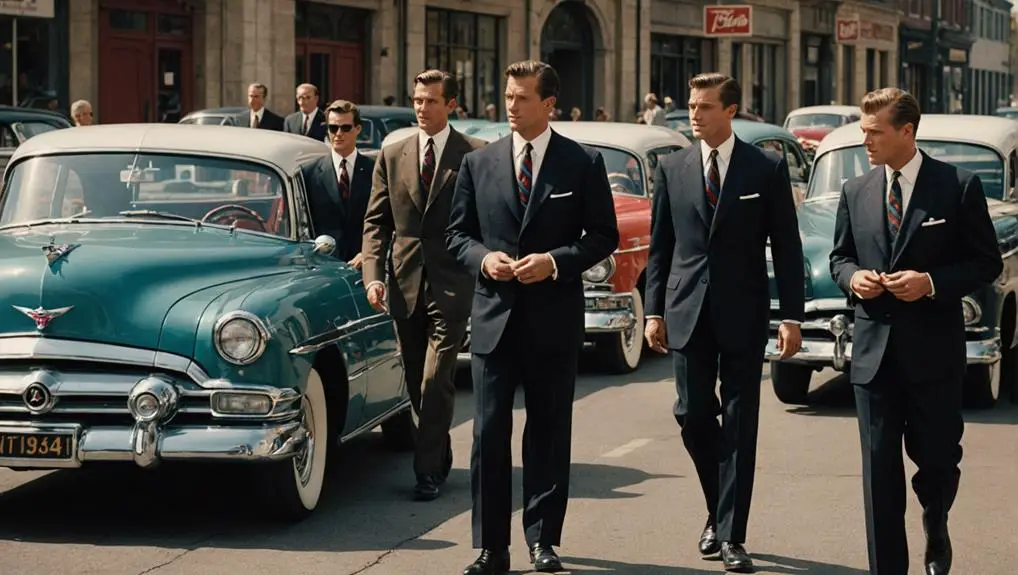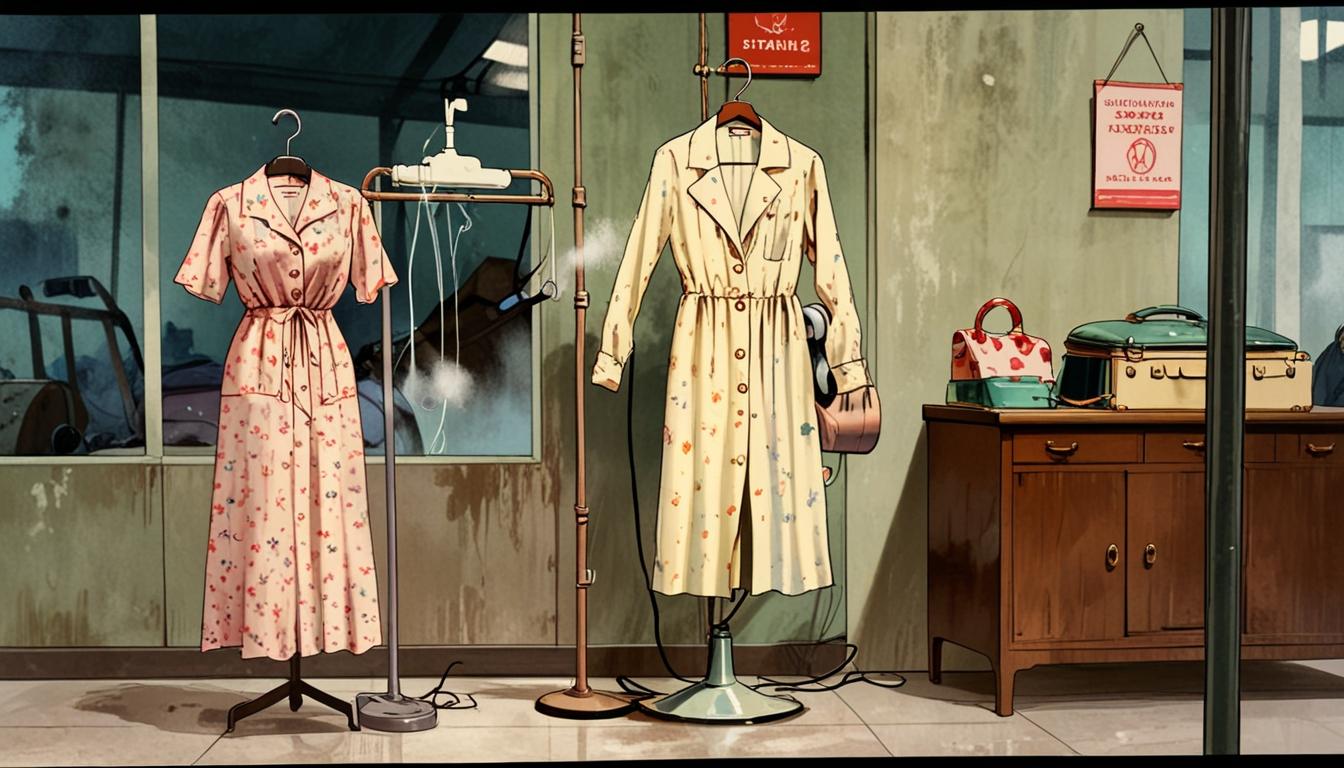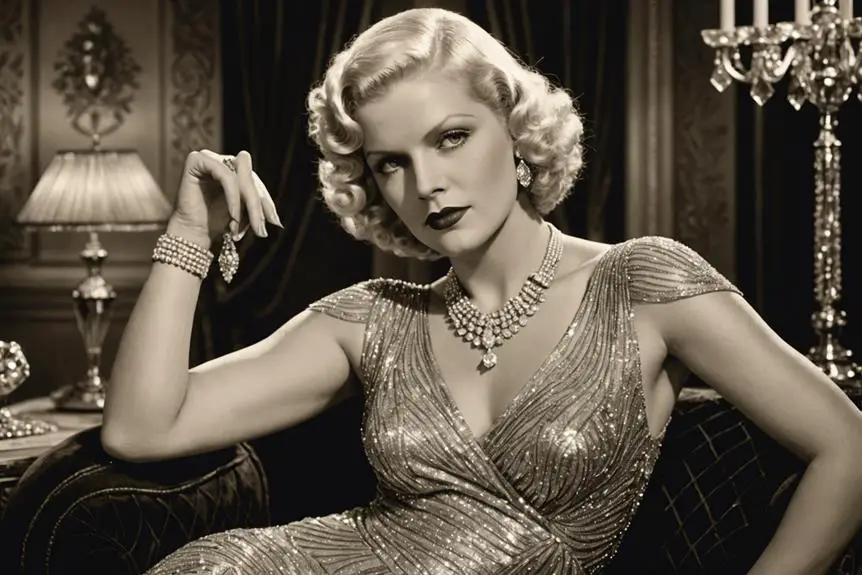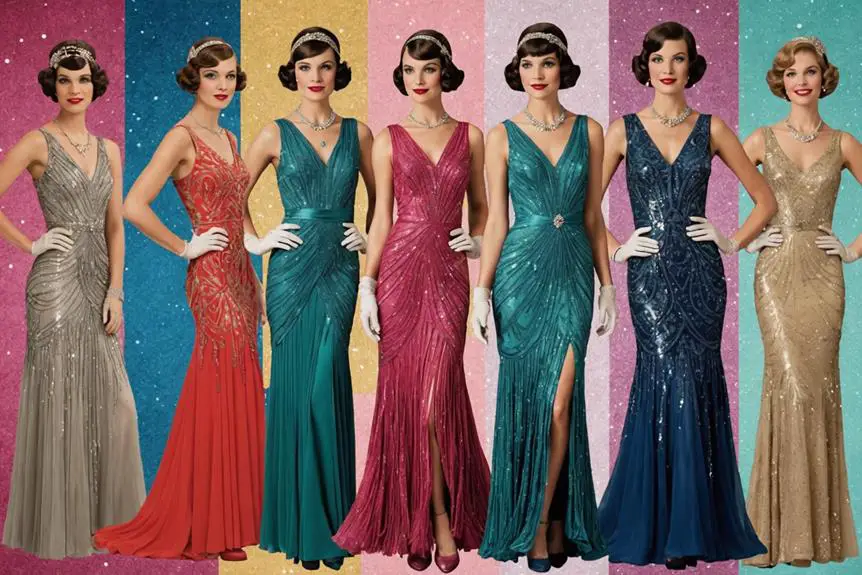Men's ties and bowties in the 1950s reflected a stylish fusion of sophistication and cultural expression. You'd find slimmer neckties and vibrant bowties, popularized by icons like Cary Grant and Frank Sinatra. Patterns like foulard and geometric designs dominated, often crafted from luxurious rayon satin jacquard. Clip-on options catered to a desire for convenience while maintaining polished appearances. Prices ranged from about $10 to $30, making these accessories accessible to many. This era not only shaped modern menswear but also set the tone for future fashion trends. Explore further to uncover how these styles evolved over time.
Overview of 1950s Tie Styles
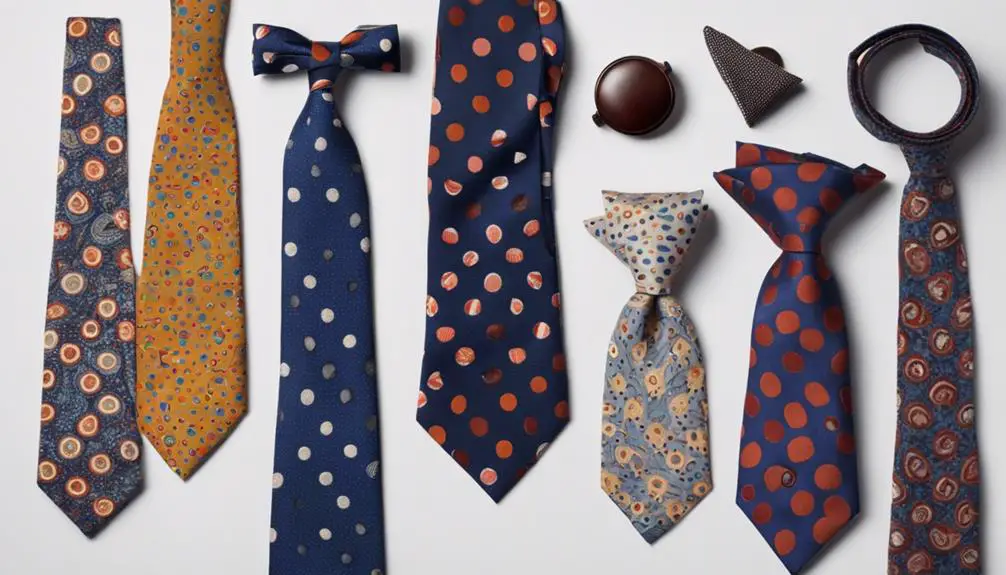
In the 1950s, men's ties became more than just a functional accessory; they embodied the era's evolving fashion sensibilities. This decade ushered in a preference for slimmer neckties, perfectly aligning with the clean-cut Ivy League aesthetic that dominated men's fashion. You'd find ties featuring tapered designs, which not only enhanced the tailored look but also reflected the sophistication men sought during this period.
Patterns played a significant role in tie styles, with unique motifs such as foulard, geometric shapes, and plaid becoming popular choices. These vibrant designs added personality to the otherwise formal attire. Clip-on ties gained traction, offering convenience to men who wanted a polished appearance without the hassle of traditional ties.
The fabric choices also contributed to the allure of 1950s ties; silk and rayon were favored for their luxurious feel and durability, reinforcing the high-quality standards of vintage menswear. As men embraced a more formal aesthetic, ties became essential in completing tailored suits, making a statement about their style and refinement. Whether opting for a classic necktie or a stylish bow tie, the 1950s truly celebrated the art of accessorizing.
Popular Bow Tie Designs
Numerous bow tie designs flourished during the 1950s, reflecting the decade's vibrant fashion landscape. You'd find a variety of styles, with clip-on mens bow ties providing convenience without sacrificing flair. Many of these vintage bow ties boasted vibrant patterns, including paisley, geometric motifs, and stripes, making them suitable for both formal and casual occasions.
As the decade progressed, skinny and narrow bow ties gained traction, often crafted from luxurious materials like rayon satin jacquard. This shift emphasized a sleek and modern silhouette that defined the era's aesthetic. Classic color palettes emerged, featuring shades like navy, burgundy, and rust, which complemented tailored suits and embodied the polished look associated with Ivy League fashion.
Moreover, bow ties transcended mere accessories to become cultural symbols, embraced by trendsetters like Cary Grant and Frank Sinatra. Their influence elevated the mens bow tie as a staple in men's formalwear, making it a must-have for any stylish wardrobe. Within this framework, the 1950s created a rich tapestry of designs that still resonates with vintage enthusiasts and fashion-forward individuals today.
Pricing Trends and Insights
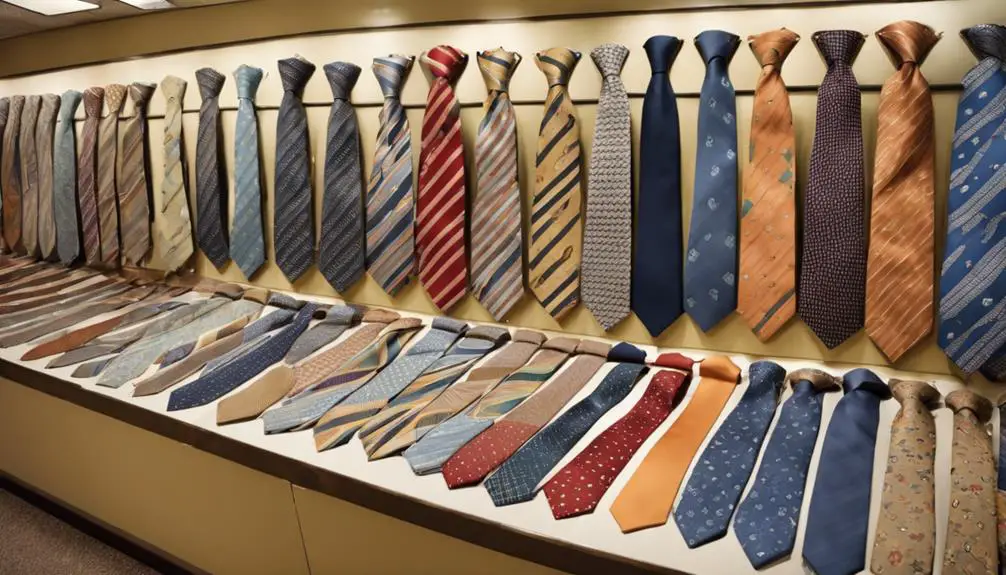
The vibrant designs of bow ties in the 1950s not only reflected the era's fashion sensibilities but also influenced their pricing dynamics. You'll find that the average price point for men's ties and bowties typically hovered around $19.99, with most items ranging from $10 to $30. This pricing structure highlighted the market's diversity and consumer preferences.
- Vintage clip-on bow ties often priced between $12.00 and $22.00, appealing to those seeking convenience.
- High-end unique designs could soar above $40, showcasing their collectible nature.
- Discounted prices were common, with sales occasionally slashing prices from $22.00 to about $19.80.
- Rare and distinctive bow ties even commanded prices reaching up to $58.00, signaling their desirability.
These pricing trends illustrate how the 1950s market balanced affordability with a flair for the unique. Whether you were a dapper gentleman looking for a classic accessory or a collector enthusiastic to snag a vintage piece, the bow tie landscape offered options that catered to various tastes and budgets. Understanding this era's pricing can enhance your appreciation for the timeless elegance of these accessories.
Materials and Durability
Many vintage ties and bowties from the 1950s stand out due to their exceptional materials, which greatly enhance their durability and overall appeal. Ties crafted from rayon satin jacquard and rayon boucle not only feel luxurious but also showcase intricate woven patterns and vibrant colors, reflecting the fashion trends of the era. This craftsmanship contributes to their longevity, making them perfect for both casual and formal occasions.
In the domain of bowties, some were made with royal rust-resistant materials, guaranteeing they could withstand regular use without significant wear and tear. Their ease of cleaning and maintenance further adds to their desirability among collectors and fashion enthusiasts.
| Material | Key Feature | Durability |
|---|---|---|
| Rayon Satin Jacquard | Luxurious feel | High |
| Rayon Boucle | Unique woven patterns | Medium |
| Rayon Shantung | Smooth texture | High |
| Rust-Resistant Bowties | Resistant to wear and tear | Very High |
These elements illustrate how the materials used in the 1950s ties and bowties not only define their aesthetic appeal but also guarantee they stand the test of time.
Influential Fashion Icons
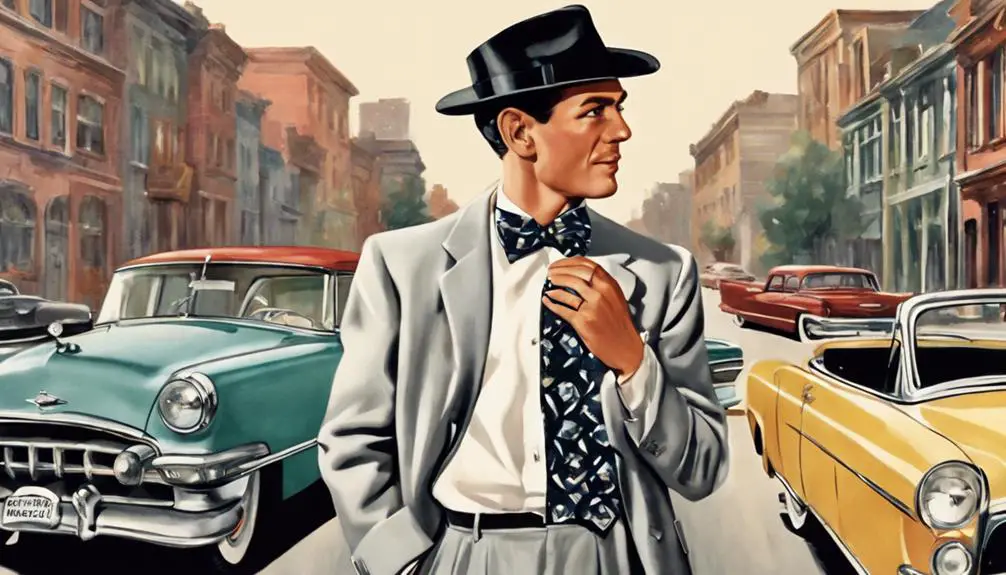
After exploring the materials and durability of 1950s ties and bowties, it's clear that style wasn't just about fabric; it was deeply influenced by the fashion icons of the era. These figures shaped the way men viewed ties, transforming them into essential elements of personal style.
Consider the following influential icons:
- Cary Grant, with his elegant tailored suits and slim ties, set a benchmark for sophistication.
- Frank Sinatra, exuding classic charm in sharp suits and his signature fedora, influenced formal wear with his polished look.
- Steve McQueen, showcasing rugged charm, often donned understated ties that reflected his relaxed yet stylish persona.
- James Dean, the face of youthful rebellion, popularized a laid-back style with loose-fitting shirts and minimalistic ties, resonating with the youth culture of the time.
Moreover, Miles Davis brought jazz flair to the mix, favoring bold patterns and colors in his ties, including striking blue striped designs. These mens vintage pieces not only enhanced their looks but also conveyed individual identities, making ties a canvas of self-expression during the dynamic decade of the 1950s.
Cultural Impact on Neckties
Often, the cultural landscape of the 1950s played an essential role in shaping necktie trends, reflecting broader societal shifts and attitudes. Hollywood icons like Cary Grant and Frank Sinatra set standards for men's elegance, inspiring you to adopt a more sophisticated look. The "Mister T" style, popularized by Esquire magazine, emphasized tapered suits and slimmer lapels, leading to the rise of thinner neckties. You'd find that these ties complemented the streamlined silhouettes of the time, making them essential accessories. As collectors of vintage clothing appreciate the craftsmanship behind each piece, the unique labels and tags from this era provide insights into the styles worn by these icons, showcasing the intersection of fashion and identity vintage clothing labels.
As post-war optimism flourished, foulard patterns and geometric motifs became prevalent, signaling a cultural shift towards modernity and innovation in menswear. Meanwhile, the emergence of rock and roll introduced a youthful rebellion, encouraging bolder colors and designs in neckties. You might stumble upon vibrant pieces like a blue clip-on bow or a brown paisley tie, reflecting this newfound expressiveness.
Social changes also encouraged a more casual yet polished appearance, making ties versatile enough for both formal and informal outfits. Overall, neckties in the 1950s became not just fashion statements but markers of evolving identity and cultural expression.
Shopping for Vintage Ties
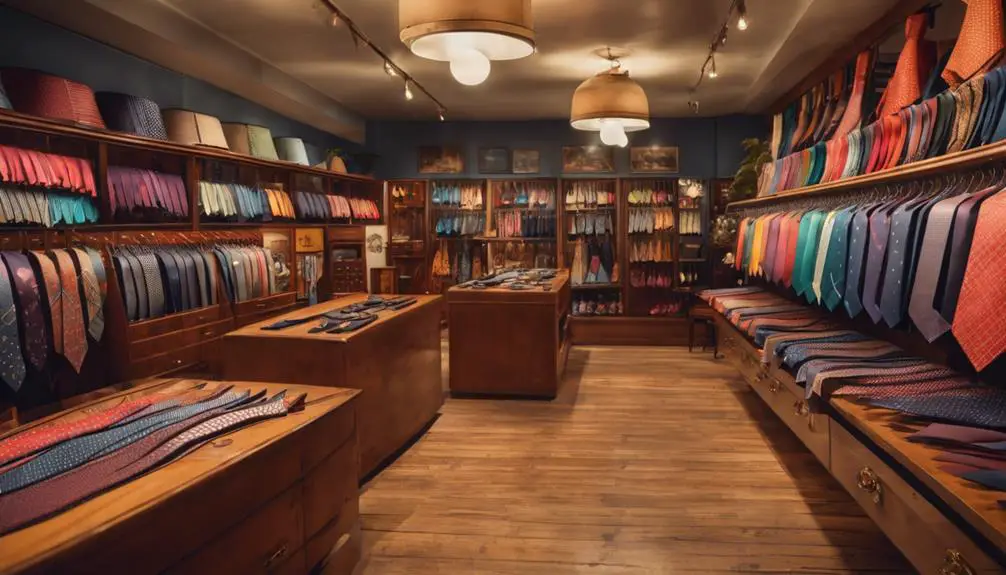
Shopping for vintage ties can be an exhilarating journey through the fashion of the 1950s, where unique patterns and styles await discovery. As you explore the diverse offerings, you'll encounter an array of ties that embody the era's charm, including the historical context of vintage clothing labels that provide insight into each piece's provenance.
- Skinny ties in vibrant blue, perfect for a retro look.
- Bow ties adorned with intricate paisley designs in rich brown, ideal for formal occasions.
- Clip-on options featuring playful stripes, making style accessible to everyone.
- Floral patterns that evoke nostalgia, suitable for themed events.
When hunting for these gems, consider platforms like RustyZipper.com or various auction sites, where you can find vintage pieces made from quality materials like rayon satin jacquard. This fabric guarantees durability while showcasing timeless aesthetics. Pricing varies, with vintage bow ties typically ranging from 61.89 SEK for simpler designs to 412.59 SEK for high-end options. Don't hesitate to check detailed descriptions and customer reviews to make informed choices. Whether you're a collector or just looking to add a touch of 1950s flair to your wardrobe, vintage ties offer a delightful blend of history and style.
Frequently Asked Questions
Did Men Wear Bow Ties in the 1950s?
Yes, you'd find men sporting bow ties during that era, often at formal events. Their popularity soared, thanks to iconic figures, unique patterns, and the convenience of clip-ons, making them a stylish choice for many.
When Did Men Start Wearing Bowties?
You'll find that men started wearing bow ties in the mid-19th century. Their origins trace back to Croatian mercenaries, evolving into a fashionable accessory by the early 20th century, gaining popularity in formal settings.
How Wide Were Ties in the 1950s?
In the 1950s, ties typically measured 2.5 to 3.5 inches wide, with 3 inches being standard. This shift toward slimmer styles reflects changing fashion preferences and the influence of youth culture during that era.
When Was the Bow Tie Most Popular?
The bow tie peaked in popularity during the mid-20th century, especially in social settings. Its unique charm and versatility made it a favorite for formal occasions, reflecting elegance and sophistication that you'd want to embody.
